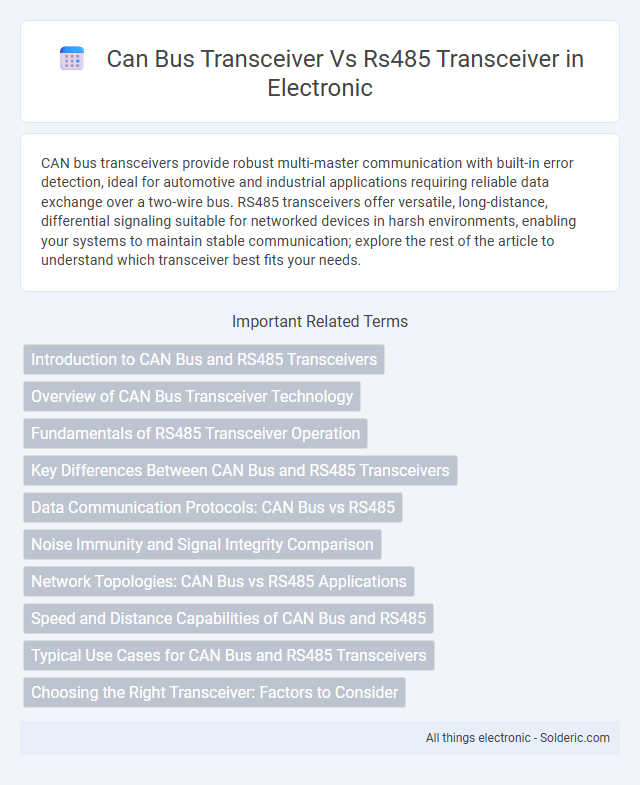CAN bus transceivers provide robust multi-master communication with built-in error detection, ideal for automotive and industrial applications requiring reliable data exchange over a two-wire bus. RS485 transceivers offer versatile, long-distance, differential signaling suitable for networked devices in harsh environments, enabling your systems to maintain stable communication; explore the rest of the article to understand which transceiver best fits your needs.
Comparison Table
| Feature | CAN Bus Transceiver | RS485 Transceiver |
|---|---|---|
| Protocol | Controller Area Network (CAN) | RS485 (Differential Serial Communication) |
| Data Rate | Up to 1 Mbps (Classical CAN) | Up to 10 Mbps (short distance) |
| Network Topology | Multi-master, bus topology | Multi-drop, bus topology |
| Maximum Nodes | Up to 120 nodes (typical), depends on transceiver | Up to 32 devices standard, expandable with repeaters |
| Error Handling | Built-in error detection and fault confinement | Error detection limited; depends on upper-layer protocol |
| Signal Type | Differential, dominant/recessive bits | Differential signals |
| Typical Applications | Automotive, industrial control, automation | Industrial networks, building automation, instrumentation |
| Physical Layer | ISO 11898-compliant transceiver | TIA/EIA-485-A standard transceiver |
| Power Consumption | Moderate; designed for automotive environments | Low to moderate, depends on usage |
Introduction to CAN Bus and RS485 Transceivers
CAN Bus transceivers facilitate robust communication in automotive and industrial networks by enabling differential signaling for fault tolerance and high noise immunity. RS485 transceivers support long-distance, multi-point serial communication through balanced differential signaling, commonly used in industrial automation and data acquisition systems. Both transceivers convert logical signals to physical layer signals, ensuring reliable data transmission in electrically noisy environments.
Overview of CAN Bus Transceiver Technology
CAN bus transceivers enable robust communication in automotive and industrial applications by facilitating differential signaling with built-in error detection and fault confinement, ensuring reliable data exchange on a multi-node network. These transceivers operate using a two-wire system (CAN_H and CAN_L) to minimize electromagnetic interference and allow high-speed data transfer rates up to 1 Mbps. Unlike RS485 transceivers, CAN transceivers incorporate protocol-specific features such as message prioritization and arbitration, optimizing bus efficiency and network stability in complex control environments.
Fundamentals of RS485 Transceiver Operation
RS485 transceivers operate by enabling differential signaling over twisted pair cables, which enhances noise immunity and allows multi-point communication. They support half-duplex or full-duplex transmission, with balanced drivers and receivers that facilitate data exchange up to 4000 feet at speeds reaching 10 Mbps. RS485 transceivers are designed to manage bus contention and maintain signal integrity through fail-safe biasing and precisely controlled line impedance.
Key Differences Between CAN Bus and RS485 Transceivers
CAN bus transceivers and RS485 transceivers differ primarily in protocol complexity, data handling, and network architecture. CAN transceivers support priority-based arbitration and error detection for real-time automotive and industrial control systems, while RS485 transceivers enable simpler, long-distance, multipoint communication with basic differential signaling. Your choice depends on application demands: CAN excels in robust fault-tolerant environments, whereas RS485 suits straightforward, cost-effective serial communication over extended cabling.
Data Communication Protocols: CAN Bus vs RS485
CAN Bus transceivers utilize the Controller Area Network protocol, designed for robust, real-time communication in automotive and industrial environments with built-in error detection and multi-master capabilities. RS485 transceivers operate using a differential signaling standard often paired with protocols like Modbus, facilitating long-distance, noise-resistant data transmission in industrial networks. Your choice depends on whether you require sophisticated error handling and message prioritization from CAN or the simpler, cost-effective multi-point communication provided by RS485.
Noise Immunity and Signal Integrity Comparison
CAN bus transceivers exhibit superior noise immunity due to their differential signaling combined with built-in error detection mechanisms, making them highly resilient in electrically noisy automotive environments. RS485 transceivers also use differential signaling, providing robust noise resistance for long-distance industrial communication, but they lack inherent error-checking features, which can affect overall signal integrity. Signal integrity in CAN transceivers benefits from tight timing specifications and controlled slew rates, whereas RS485 transceivers prioritize longer cable lengths at the expense of slightly reduced signal precision.
Network Topologies: CAN Bus vs RS485 Applications
CAN bus transceivers support multi-master networking with a robust broadcast communication ideal for automotive and industrial systems requiring error detection and fault confinement. RS485 transceivers excel in point-to-point or multi-drop bus topologies suited for long-distance, noise-resistant industrial automation and building control networks. Your choice depends on whether you prioritize the sophisticated error handling and priority messaging of CAN or the straightforward, scalable connectivity of RS485.
Speed and Distance Capabilities of CAN Bus and RS485
CAN bus transceivers typically support data rates up to 1 Mbps over distances of up to 40 meters, with speed decreasing as distance increases. RS485 transceivers can achieve speeds up to 10 Mbps but are usually limited to shorter distances under 50 meters at top speed, while extending communication up to 1200 meters at lower speeds around 100 kbps. Your choice between CAN bus and RS485 transceivers depends on the balance you need between data transfer speed and communication distance.
Typical Use Cases for CAN Bus and RS485 Transceivers
CAN Bus transceivers are typically used in automotive systems, industrial automation, and robotics due to their robustness in noisy environments and real-time communication capabilities. RS485 transceivers excel in long-distance industrial applications, such as building automation, HVAC systems, and factory equipment, where multi-drop networks and extended cable lengths are essential. Your choice depends on the network complexity and the environment's electrical noise tolerance requirements.
Choosing the Right Transceiver: Factors to Consider
Choosing the right transceiver between CAN bus and RS485 depends heavily on application requirements such as data rate, network topology, and noise immunity. CAN bus transceivers excel in automotive and industrial environments with real-time communication needs and robust error handling, supporting speeds up to 1 Mbps. RS485 transceivers offer longer communication distances up to 1200 meters, higher noise tolerance in harsh environments, and support multi-point bus configurations, making them ideal for building automation and industrial control systems.
can bus transceiver vs rs485 transceiver Infographic

 solderic.com
solderic.com